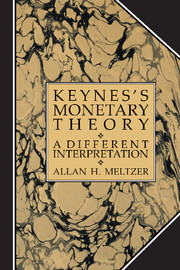Book contents
- Frontmatter
- Contents
- Preface
- 1 Introduction
- 2 Keynes in the 1920s: ideas, beliefs, and events
- 3 Theories, implications, and conjectures in the 1920s
- 4 The General Theory: a different perspective
- 5 Monetary reform and international economic order
- 6 Other interpretations of the General Theory
- 7 Conclusion
- References
- Index
4 - The General Theory: a different perspective
Published online by Cambridge University Press: 05 September 2009
- Frontmatter
- Contents
- Preface
- 1 Introduction
- 2 Keynes in the 1920s: ideas, beliefs, and events
- 3 Theories, implications, and conjectures in the 1920s
- 4 The General Theory: a different perspective
- 5 Monetary reform and international economic order
- 6 Other interpretations of the General Theory
- 7 Conclusion
- References
- Index
Summary
A fledgling economist approaching Keynes's General Theory for the first time expects to find the policy recommendations derived from a theory that everyone knows to be “Keynesian.” Although much of the thought and apparatus identified as Keynesian is there – underemployment equilibrium, liquidity trap, spending multiplier, downward wage “rigidity” – there is little about pump priming, tax cuts, and carefully timed changes in government spending or tax rates to spur recovery. To find this type of fiscal policy recommended in Keynes's work one must look to Keynes's popular writings, many of them written before the General Theory. Keynes of the Treatise on Money, who had not yet succeeded in the “long struggle of escape” from “habitual modes of thought and expression” (7, p. xxiii), gives at least as much attention to fiscal policy as Keynes of the General Theory, who mentions public works spending in a few passages of the chapter on the multiplier (ibid., Chapter 10) but neglects to mention public works in his “Notes on the Trade Cycle” (ibid., Chapter 22). There, as in other parts of the book, Keynes's main recommendation is for social management of investment.
The General Theory is addressed to economists (ibid., p. xxi).
- Type
- Chapter
- Information
- Keynes's Monetary TheoryA Different Interpretation, pp. 115 - 204Publisher: Cambridge University PressPrint publication year: 1989
- 3
- Cited by

